My garage needs a workbench, but where?

My garage is attached to the back corner of my house, as that was the only way to build it and respect the town’s requirement of a four-foot setback from the property line. Its 31- x 17-foot size was the maximum allowable under a different building code that puts a limit on the ratio of the home’s square footage to that of the property. The garage’s low ceiling, which precludes having a real walk-under post lift, is due to the fact that a high ceiling would’ve obstructed the view out the dining room window.
In other words, the garage is a compromise solution that navigated a number of obstacles on its way to fruition. It is a triumph of the good over the perfect. From the suburban streets of Newton, Massachusetts, you don’t see the garage at all. From the backyard, it sticks out like an ovipositor on the butt of a wasp.

Although I love my garage and am blessed to have it, there are a number of issues with it. All access is through a single roll-up door at the front. There’s a double-width roll-up door on the rear side, intended to allow a big hooked J-turn into the garage and put one car cross-wise in the back, but I’ve never used it that way. Instead, even though we didn’t design it for this, I discovered early on that, since most of my vintage cars are short (a BMW 2002 is a little under 14 feet), I can fit two of them straight-in nose-to-tail, obviating the need for the awkward car-crosswise-in-the-rear thing. I back a third car in, do a dog-leg turn, and put it in the left rear of the garage. This fits three cars and leaves an empty space on the front left.
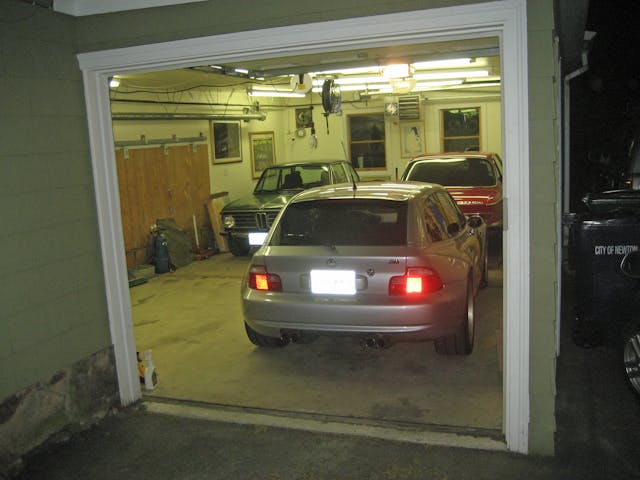
I can and have squeezed a fourth car in there by sliding it sideways on wheel dollies, but \for several reasons I haven’t done so in a few years. It takes a bit of work to pull off the maneuver. The floor slopes slightly toward the back for drainage, which means that a car on roller dollies will tend to drift rearward. To stop it, I have a wooden runner screwed into the floor, but the wheels of the roller dollies jam up against it. And with four cars sardined in there, it becomes difficult to get any serious mechanical work done over the winter, as there’s very little room to move. I know I constantly complain about my warehouse storage in Monson, but since it’s expandable, it’s just easier to cap the number of cars in my garage at three.
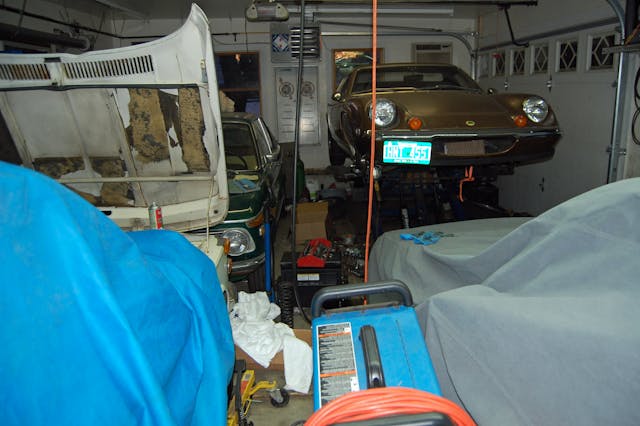
What’s clearly missing in the garage is a workbench to act as both a general-purpose table as well as to hold the bench vise, the table-top grinder, the Scotch-Brite wheel, the band saw, and the drill press that all instead sit on my basement floor. Since I don’t have one, when I’ve needed a work surface, I’ve used a fold-up card table that can barely support the cylinder head I’m working on, much less host a bench vise. Because there’s no broad horizontal work surface, the fourth open space on the garage floor becomes a magnet for, well, everything—tools, new parts I’ve bought that are waiting to be installed, things I’m in the middle of rebuilding, etc. And in order to drive the car that’s in the third space, I need to move all of it.
A separate but overlapping issue is the problem of boxes. For a while, the boxes littering the floor were predominantly full of parts I’ve been gifted from people who’d sold their (or their departed family member’s) BMW 2002, but recently also came to include stuff from selling my mother’s house (I mean, how am I supposed to leave boxes of new light bulbs and painting supplies behind?) and selling my truck (I mean, how am I supposed to leave behind all those tools that were in the truck’s utility body from when it was my geophysics field vehicle?). All of this winds up on the floor in the fourth space along with the welder I never use and the floor jacks.
The fundamental problem is that the garage is just a little too small for the way I try to use it (of course, the fact that I’m a tornado of chaos contributes immensely). I’m thrilled that the garage’s dimensions make it possible to fit three cars and squeeze in four, but it’s challenging to put a workbench inside. There’s zero room along the right wall. There’s barely room along the back part of the left wall. I do have a small parts washer there, but the car in the third space comes within 18 inches of it; I doubt I could put a workbench and a chair there. There’s a door to an under-deck storage closet along the front left wall that I don’t want to block. It’s possible that a bench could go in the left rear, behind the third space, but the floor of that area is still full of stuff.
Now, I’ve tried several times before to do a better job of organizing the garage, but I always lose momentum and fall back to doing the bare minimum that’s necessary to do whatever it was that I really needed to do, which is usually clearing the floor so I can simply get the third car out of the back space and drive it. I decided to take another run at it, this time with the realistic goal of doing enough organization and configuration to keep the fourth space clear so I can pull the car in the third space in and out without making it a floor-clearing project each time, as well as enabling the possibility of a workbench in the back.
If I haven’t made it clear, stuff on the floor is death to efficient use of space not only because it takes up the space on the floor, not only because you can’t drive over it, but because it essentially occupies all the space above it as well—unless it’s stackable crates, little else can be put on top of it. The obvious solution is shelving. Over the decades, I’ve shelved most of the available wall space in both the basement and the garage. Most of this is wire shelving on wall-mounted brackets and standards, but a few years ago I bought two rolling wire shelving units. There’s a sliding door on the left wall that opens up under the back porch where I have big items like the engine hoist stored. By having rolling shelves instead of wall-mounted ones, it allows the possibility (the slim possibility, but the possibility nevertheless) of rolling the shelves out of the way in case I need access to these items. I ordered two more of these rolling shelf units on Amazon and tackled the boxes of junk that were in the way of where I wanted to put them.
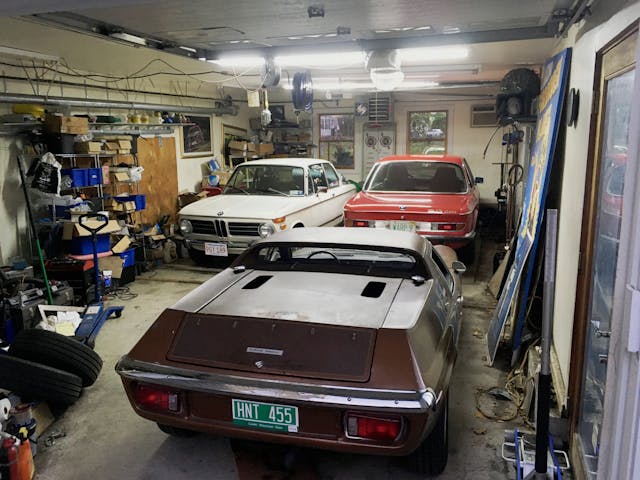
Getting boxes out of the way of where you want to put shelving is definitely a case of things getting much worse before they get better. One by one, I disgorged the contents of boxes (many of which had rotted bottoms) directly onto the garage floor, threw things out, tossed other things in the scrap metal pile, combined like with like, put them in new boxes, and put them up on the shelves.
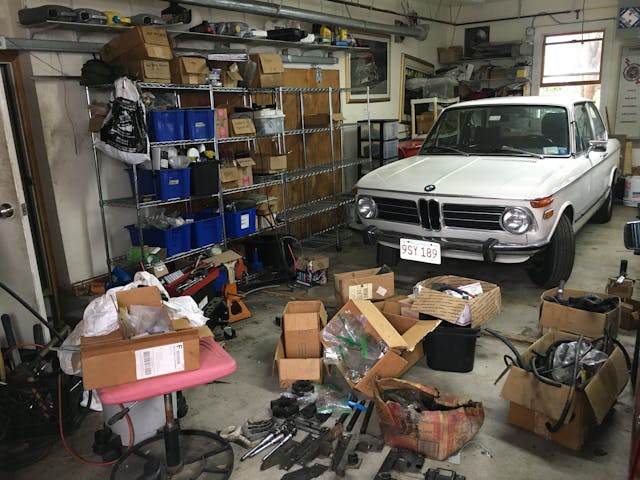
But boy, it’s easy to get sidetracked. I accumulated all the BMW 2002 shift platforms and related transmission and clutch parts left over from when I’d performed five-speed conversions in several cars. I had four shift platforms. Did I need to keep all of them? No. The platform itself is not a rare part that wears out; only the detachable rubber bushings do, and they’re readily available. Still, someone might one to shorten it for a five-speed conversion. Should I give them away? I’ve done a lot of this in the past, and it takes time. I fought my tendency for analysis/paralysis and instead kept two of the good ones and threw the two grimy ones in the scrap metal heap.
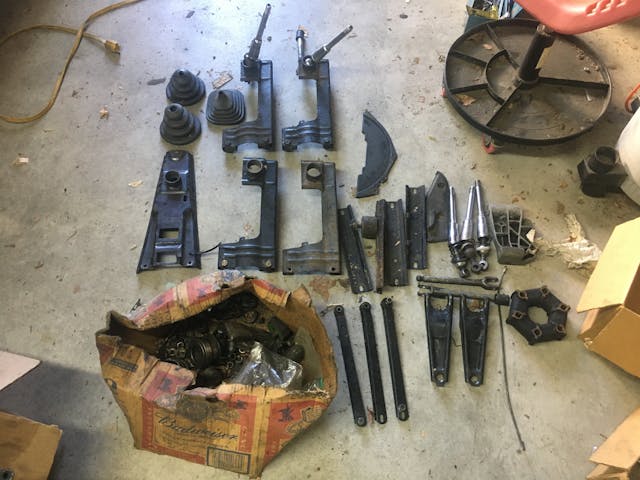
Then I went through the same thing with old cooling system parts. I had seven 2002 thermostats. Granted, there’s some value in saving these things when a) thermostats go bad far less often than we’ve been led to believe, and b) the old ones may be of higher quality than the new ones, but seven? I picked two OE-manufacturer thermostats with low opening temperatures and recycled the rest.
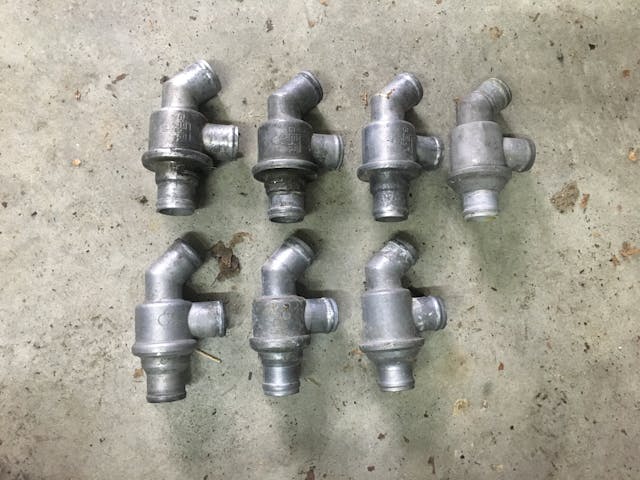
Another issue has been my tendency to keep donated parts together in their original boxes. I’ve been the beneficiary of a number of BMW 2002 parts hoards over the years, several donated by the spouses of their deceased husbands. One fellow was fastidious in his accumulation and bagging of small interior parts. Another had a fine assortment of barely-used under-hood ignition parts that were replaced with higher-performance versions. I’ve kept these collections intact for years, but the time had come to organize by functionality rather than by donor.
If I may continue for a moment longer on the issue of boxes, if the floor is death, boxes are death, too. The problem with boxes is that while they’re necessary for organization and storage, their very presence legitimizes their contents. Just because a box is clearly labeled “Old BMW 2002 ignition parts” doesn’t mean that it isn’t all just junk. A time comes when it’s necessary to dump the contents on the floor, give everything a good hard look, separate the wheat from the chaff, pitch the junk, and redistribute the good stuff. I was particularly merciless with the box of parts from the rebuild of the Lotus Europa’s engine. I mean, used rings, bearings, valves, and timing chain? Out it all went. The edge of silliness of this curve was encountered when I found a box that contained the cleaned-out contents of a car before I sold it. It wasn’t even my car—this was a favor I did for a friend six years ago. So this wasn’t even my stuff. I shredded the old registration and threw the rest away.
In addition to shelving, I have an endless need for drawers and find the plastic multi-drawer storage units very handy. The tall seven-drawer units were a little more expensive on Amazon than I expected, but I found someone on Facebook Marketplace who has a side hustle selling used furniture and delivered one to my house for $45. A few hours and a bunch of plastic take-out containers later, and I had a decently-organized set of drawers with metal and plastic trim clips, small interior screws, zip ties, gaskets, rubber seals and grommets, BMW 2002tii fuel injection parts, and the like.

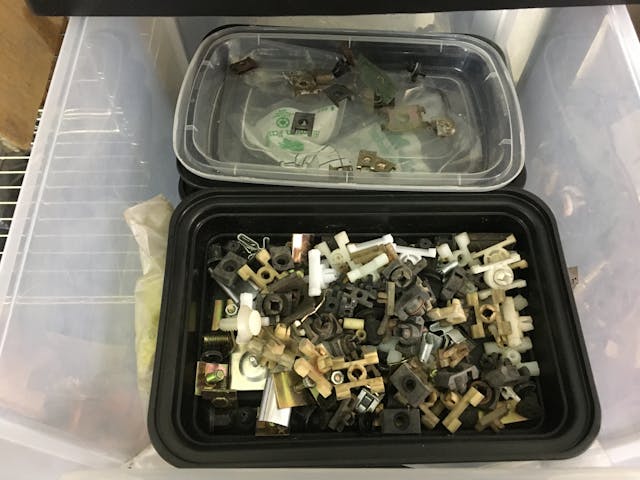
One of the toughest things to deal with has been the tools, as I’ve accumulated redundant sets of them from different sources. The most recent motherlode came from the work truck I just sold—full SAE and metric toolboxes, as well as several ratchet sets in small fold-open plastic cases, were left in it when the truck was largely abandoned when the company I worked for closed the building where it was based. At some point I need to do the full-on anal-retentive organization of, for example, grouping all the ½-inch tall metric sockets together on a socket rail, repeating for all the different socket sizes and types, making one high-quality master tool box, one house tool box, and two road tool boxes, and then taking whatever’s left over down to my local used tool store to sell for pennies on the dollar. But in the meantime, I simply needed this stuff off the floor. My brain and my search patterns were in wire-shelving-mode, so what I found on Amazon was a three-tier wire shelf cart for $80. It does the job. But much of online purchases hinges on using the correct search terms, and in retrospect, looking at “tool carts” would’ve yielded a better solution. Still, several tool boxes and big stuff like sledgehammers and crowbars are now off the ground and roll-able.
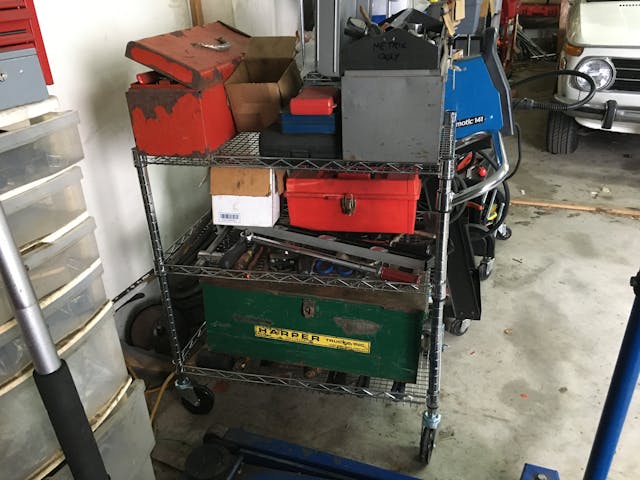
As the garage got way more organized and the fourth space was cleared, the need for a table or workbench made itself known in a funny way. There’s a tall wastebasket in the garage that I’d filled with trash but hadn’t emptied yet. At one point, while dealing with empty boxes I’d slated for recycling, a shallow cardboard tray that originally held a case of carbonated water wound up sitting on top of the wastebasket. Before I knew what had happened, it filled up with stuff—hats, flashlights, T-shirts, a metal box filled with old keys—that I wasn’t sure what to do with. In other words, I began using the first available horizontal surface as a table. “No!” I said to myself. I recycled the box and found longer-term homes for these things or threw them out. As I continued dealing with smaller groupings of stuff—a few electrical components, some molding clips—they naturally found their way onto … other horizonal surfaces, like the tops of toolboxes. The point is that whether you have a table or a workbench or not, one is going to invent itself because the need is never going to go away.
So, no, I don’t have a workbench in the garage yet, but I do now have everything off the floor in the fourth space. I won’t be storing another car in it, but that wasn’t the goal—the goal was making it so I can easily drive the car into space #3. I’m there. Regarding the workbench, I can see light at the end of the tunnel. Once I clean out the stuff behind space #3, I can put a workbench back there.
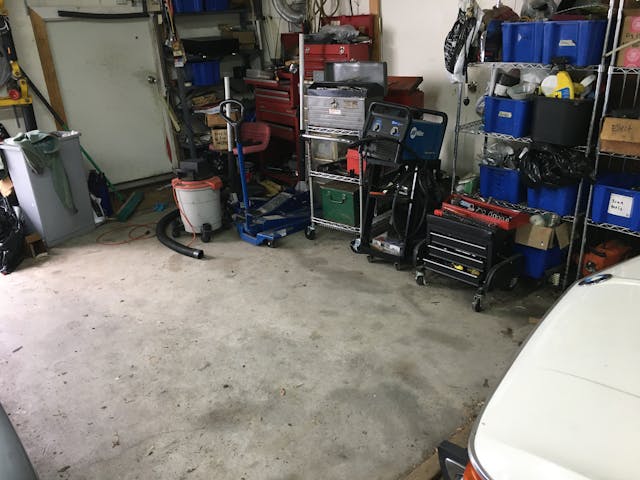
The only problem is … I sold the truck that I would’ve used to drag home an inexpensive, used work bench.
Damn. Why don’t I ever think these things through?
***
Rob’s latest book, The Best Of The Hack Mechanic™: 35 years of hacks, kluges, and assorted automotive mayhem is available on Amazon here. His other seven books are available here on Amazon, or you can order personally-inscribed copies from Rob’s website, www.robsiegel.com.
Check out the Hagerty Media homepage so you don’t miss a single story, or better yet, bookmark it. To get our best stories delivered right to your inbox, subscribe to our newsletters.


You have hit on all the points needed. Organization and things on the floor take up space.
It comes down to just how bad you want a bench?
#1 draw up a plant on how you want to set the garage up.
#2 get to looking for the bench you want. Wood? Steel? storage under it?
#3 Shelfs and wall cabinets can help much as well over head storage as the end of the garage where you will not hit you head.
Benches are a blessing and yes even once you get it you will need to be disciplined to clear it off or you will just stack junk on it and be unable to work.
I put one on each side and yet still have to fight putting things on them and not clearing them off as often as I should. We are all guilty.
Those with no benched tend to stack on cars.
The rule of garages is no matter how big you build it you are always 4′ too short.
Rob great tail. A couple of questions:
1. Why not knock the deck off the back of the house and expand the garage to fill the space at the rear of the house? It would make the garage L shaped and you could put your work area and storage in that part to free up the garage for cars. Also you could then use the roof as the new deck.
2. Blow out the back wall and extend the garage back to the rear property line this would most likely double your floor space and allow for workspace but you could then get up to six cars in the garage.
3 Lastly I have found clear plastic tube more efficient for finding things. I see you are using old boxes and most times we forget what is in then even if they are marked.
Thanks and Happy Halloween
Helen
Garage contents are technically gases and will expand to fill their containers
👍
Nature abhors a vacuum. And Mrs. DUB6 abhors an open, horizontal space. It’s all her fault that every square foot of open space in my garage, shop, shed and barn is occupied by “stuff”. All her fault. Yep. Hers. Hers and hers alone.
Anybody out there convinced yet?
To paraphrase Shakespeare, me thinks thou doth protest too much.
😁
(methinks the lady might agree)
Rob, funny overview. I get it. I built a very strong rolling work bench out of 4×4 doug fir (legs and frame) and 3/4 inch plywood. Reinforced with Simpson Ties in the corners, has 4″ locking roller wheels (orange urethane), plus aditional shelf underneath. Very handy and moveable. It can easily take a vice, or grinder. I built 2. One is 4×4′ (half sheet of plywood) I use that inside my 20 x 20′ garage. The other is a full-sheet 4×8 rolling bench, I use outside for projects. I got all of it at Home Depot for $100-120 for the 4×4. The 4×8 a little more.
I’d send a pic, but don’t see that option. Peter G. / San Diego
Could be worse. You could have started collecting Cadillacs instead of BMWs. Then you would have, effectively, a 1 car garage.
I once owned a house with a nice 3 car garage. The garage was 221 inches deep, just long enough for an Eldorado, but several inches too short for an Imperial. I sold the Imperial.
Folding Scaffolding with extra planks! As someone who went through a garage addition with similar constraints (don’t exceed the property setbacks, lot square footage restrictions, don’t block wife’s view from the house windows), I’ve found the answer to the garage storage question to be folding scaffolding and toolboxes. Rolling tool boxes/cabinets are available in various sizes, but if you get the ones with lots of drawers, they hold a tremendous amount of stuff that would otherwise be in boxes on shelves. If you can find a blow out deal on tool chests with lots of drawers you can stack them on shelves and replaces boxes with something much more accesible.
Rolling tool boxes without a top box make great workbenches: they usually have excellent weight ratings, you can bolt a vice/grinder/sander to the top (and a wooden top if it doesn’t already have one). If you leave one drawer ’empty’ and designate it as the temporary junk/project drawer – you can strive to keep the top clear. Plus when you need to squeeze that extra car/project in the garage, having your workbench on decent locking casters makes it much easier to reconfigure.
If you just need a workbench top and really need more floor space at times (you need more floor space; and you also need more drawers), folding workbench/tables are also nice, but I made an interesting discovery after borrowing a pair of Baker/Perry style scaffolds to build the garage. A Baker/Perry scaffold is a modular scaffold that has a 30″x72″ platform on 72″ high end frames with good locking casters where you can adjust the platform height. They are typically rated to be stacked up to 3 high (18′ but they get pretty rickety!) and have a 1,000lb weight capacity (which can also feel pretty rickety depending upon the platform height). If you have a few leftover planks (or just buy them), you can make some ~76″ long shelves with 2×2 or 2×4’s screwed under the ends so that they just fit between the end frames. I usually use 2×4’s or 2×6’s for steps/braces, and 2×10’s or 2×12’s for additional platforms or shelves. You put the platform at workbench height, put 2-4 planks underneath the workbench height, and put 1 plank on each rung of the frames above the workbench and now you’ve got a 1,000lb capacity workbench with shelving that is completely reconfigurable and can be broken down and packed flat against a wall. The bonus is by making the planks fit tightly, it will brace the scaffolding – depending upon the desired platform height I usually put at least one plank on the lowest rung position and one on the tallest rung postition (they act as braces, steps, and the top one serves as a handrail/shelf). A Baker/Perry Scaffold has 5 rungs x 2.5′ x 6′ = 75 sqft of storage in something that takes up only 15sqft – plus you can adjust it to fit over things (like stored engines/transmissions). Bins/boxes/toolboxes fit nicely on such a scaffold. You can find them at most big box stores and they occasionally go on really good sales.
Now a Baker/Perry Scaffold is a bit unweildy (you put it up and down solo, but it is easier with two people) and takes up a good bit of space. The smaller folding scaffolds you can also find at big box stores and elsewhere are available in 22×41″ to 31×51″ and 3 to 5 rungs high. The ones with clip in top rails are quite a bit studier (typically rated up to 1,000lbs versus the smaller ones rated at 500lbs). They usally come with 2-3 adjustable metal platforms that you can either setup as a single deep platform or steps/shelves. Again, add your own planks and they become studier and hold more. I bought the 31×51″ which has a sturdier base but only it takes ~22″ of depth for the top four rungs. It works great as a scaffold, but most of the time its a rolling workbench in my garage with two planks at workbench height, planks serving as shelves beneath, and single planks on the upper rungs serving as shelves. These things fold up pretty neatly making your workspace very flexible as they are also on good locking casters – plus they are alot easier to maneuver solo than the bigger Baker/Perry scaffolds. You can take down the platforms, fold it up, move it throughout the house as needed. You can also bolt a vice/bench top tools to a plank (might clamp the plank to the frame for a vice or bending brake).
With a pair of these modular scaffolds, you can set up planks between them and have either shelves or working platforms of just about any length (15′ extendible plank is a bit sturdier than 16′ 2×12’s or you can get LVL).
I have had good luck bolting (large diameter, say 5 or 6″) casters (a straight pair on one end, locking swivels on the other) to the feet of pallet racking uprights. 90 inch long beams, with wooden shelves, gives me a 7-foot tall, 34 inch deep rolling “shelf” with adjustable shelf height, and the ability to move it even with hundreds of pounds of “stuff” on the shelves. I will be implementing a similar design with old metal “tech bench” legs with a heavy 36 x 60 top for a rolling workbench (with a mounted vise, etc.)
Like most people in Michigan, I have a basement which might qualify for the Hoarders Show. Also have storage above a 2 1/2 car garage. Despite all efforts to organize old parts and tools, stuff just accumulates from nowhere. Very frustrating when you know you have something but can’t find it! The solution might be to stick with one car or have cars the same make and model, but that’s no fun!
I grab up every available milk crate that I can get my hands on. Plastic totes are a good place to start, but they dry and become brittle with time and you end up in the same boat as cardboard.
Every flat surface in my garage whether intended to be a workbench or not has become a parts repository. Rather than fight the trend by adding yet another flat surface, I pick one, clean it up, and downsize inventory as needed. You have to draw your line in the sand when it comes to car space or you will end up with one of those barn find pole barns full of 20 disassembled cars and a row of 30 intake manifolds from god knows what
You need to standardise your storage boxes. Cardboard boxes are only good for temporary use only, and they don’t work for permanent storage because they don’t come in standard sizes and they’re too flimsy. Pick a standard, whether that be milk crates or a specific type of clear storage box, and stick to it religiously. Standardised boxes also make it significantly easier to sort through them and organise what is in each box.
I like milk crates for indoor storage, but they’re not ideal for garage storage because they only come in one size (mostly), they don’t have lids, and they have holes in them. Clear plastic boxes or the rubbery blue Rubbermaid Roughneck boxes are better. Costco often has inexpensive clear plastic boxes in various sizes.
Also, don’t stack boxes. One of the golden rules for creating a clean workspace is that everything must be directly accessible without moving anything else.
As Charles said, cardboard boxes have to go.
To add onto my previous comment, sometimes it’s better to put small parts into labelled heavy duty clear plastic freezer bags and put all the related bags into a shallow tote box. You can fit a lot more into the same space compared to putting stuff into smaller boxes, and the clear bags make it really easy to sort through them identify what’s in them without dumping everything onto a table.
Easy, move away from Newton further into the suburbs to get more living space, a better garage, and far more land (to store future project cars of course) … for less money or for the same money with even more space.
As I wrote a couple of weeks ago, the search for a more car-friendly property has been back-burnered for a number of reasons.
I realized 30 years ago that the suburbs wasn’t far enough. Farm liv’in is the life for me.
👍👍
Setup looks good to me, just needs that lift.
There’s a mid-rise lift under the car in the back right. The ceiling height in the garage is short, so no post lift.
I couldn’t live without a workbench and a vise – how do you do it? I always need a flat, stable surface to work on parts and assemblies that are off the car. And the vise serves for both heavy work (say hacksawing or filing) as well as as a third hand to hold a part while I work on it.
Oh my co-enthusiast what a quandary to get yourself in. As an Architect and fellow car collector I can tell you what my 40 + years of experience (and you know the saying… experience is what’s happened to you, you wish to God would happen to someone else) has shown me.
I have had the pleasure of dealing with 4 similar client situations. Two middle income and two a tad better. The smarter ones decided that life is too short and ended up moving to accommodate life’s pleasures. Yes the one wife wanted a garden and an in home office instead of a cluttered closet.
You get the idea, as my master rule when doing residential… there better be a BIG smile on your face every month you write that mortgage check.
One who had an elderly parent to take care of, was fed up having to deal with stairs and etc. but ended up finding to their surprise a house within 1.5 miles of their location and in the same school district. That family had the least dollars and the most to lose, but understood that life is short and enjoy your hobbies.
I know many situations seem insurmountable, especially dealing with Villages and zoning etc. but they will not be visiting your wake or when you’re taking that last breath looking at your cramped car collection.
Amen. 30 years ago, we looked at our city life (mandatory garbage collection, sewer hookup, city water, building codes, nosy neighbors, traffic noise, crowds, inversion pollution in winter, taxes, etc., etc., etc.) and decided to pitch it and live the life we wanted. We bought acreage, created a small ranch, designed and built our own house, garage, and outbuildings, and made a huge garden area and a small orchard. If I want to tune an engine with the headers open, no one but me can complain (well, maybe the dog, but she can go in the house). If I want to smoke a cigar and drink an adult beverage in my underwear in my back yard (I don’t, but I could if I wanted) nobody can give me grief about it.
Now, I’m not dumb enough to think that what could be done 30 years ago could be done as easily today, or that it can be done just any old place, but hey, all things are relative. The point is that what one gets must be weighed against what one is willing to sacrifice to get it. We pinched pennies for awhile, for sure. But, I can attest that we have lived a MUCH better quality of life and have been MUCH happier, probably healthier, and even though “civilization” is fast encroaching on our area, we still have our little island of peace that they can’t breach. Rketek is right – life is about choices, but we don’t get forever to decide about how we want to live.
For a number of reasons, the idea of moving is back-burnered. My current situation isn’t even close to hardship. If my wife and I BOTH swing around to moving further out, it’ll need to come in a natural organic way, not my twisting her arm because of—what?—inanimate objects? She is far more important to me than my boxes of junk.
Well we certainly didn’t make our move because of “inanimate objects”. But your point of making it a mutual decision is 100-percent correct. I didn’t think I was implying that you should make any “arm-twisting” actions -my wife was (and is) totally on board with our lifestyle change. My point was simply that sometimes you can (and should) pull the trigger on reaching an ultimate goal earlier rather than later. Life is shorter than we often think, and the older we get the faster it moves!
If you ever get to build a garage from scratch, put in a grease pit. Come to think of it, a lift may be cheaper, but I had the guy with a backhoe dig the pit when grading and I poured concrete in the bottom and laid cement blocks for walls. The slab went over the tops of the blocks. Remember to make it long enough to get in and out with the car there, and make covers for it. It is so useful. When I die I would like to see who buys the house and what the guy vs. the wife think of the pit. I would probably buy a house with no bathrooms if it had a pit…
Built my shop from scratch as a retirement gift to myself (with the wife’s approval of course). I made sure to specify 12’ walls so a full height 2 post lift could go in one bay. Man, that thing is a back saver; my friends and neighbors like it too! For storage & bench space I went to an auction at a local restoration business that was closing down (owner retired). I scored an 80 gallon 2 stage air compressor, 2 4’x8’ SS topped wooden benches, 2 roll around Metro wire shelf units, and a few other items. For extra storage I also have some pallet rack style shelving 18” to 24” deep. Retirement is good!
I’m very very empathetic with the 10 lbs of crap in a 1 lbs sack thing. IMHO, you need to solve 2 problems, and they both have a single combined solution: get a couple big(ger) rolling tool boxes to use as benches, and/or
get a couple big(ger) rolling tool boxes and put a bench above them (or build them into the bench). Tools spread throughout multiple small tool boxes is equal to parts spread throughout multiple card board boxes. And if you’re going to build (or buy) a bench anyway, it’s a wise move to put tool storage underneath (as opposed to shelves that just become blackholes of storage. Or if you need the multiple small tool boxes for certain collections of tools, build a bench that’s half tool box, half shelves (to store those smaller tool boxes).
Supplement this with a proper small(er) rolling tool cart. Fill it with the stuff that gets the most common usage (wrenches, screwdrivers, pliers, sockets/ratchets, impact, etc.) so you can roll it out front if/when needed and have most of what you need. Get a side shelf for it and you have small workbench for holding parts or a bit of fiddling with whatever.
Shop used for this stuff, like used Harbor Freight or Husky brand stuff, you can get a decent set up for a few hundred bucks, and it will pay returns for decades.